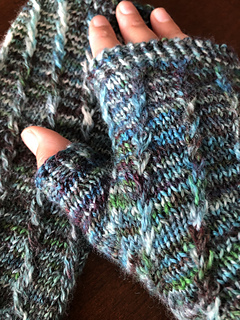patterns >  Carolyn Lisle Designs and 1 more...
Carolyn Lisle Designs and 1 more...
> Iralai Fingerless Mitts







Iralai Fingerless Mitts
The Iralai Fingerless Mitts are inspired by Antilope cervicapra, the Blackbuck (“iralai maan” in Tamil), a species of antelope from the Indian subcontinent. Its long corkscrew antlers are one of the most impressive features in the animal kingdom. They have unfortunately often been the target of poachers for this reason, so today in India they are protected by both custom and law.
Also check out the Iralai Socks and the Iralai Toque!
Pattern Description
These mitts use slipped stitches and small cables to create a twisted effect and to break up pooling. Elongating the stitches to be slipped helps keep the mitts stretchy and comfortable while also bringing out the subtle colour details we all love in hand-dyed yarns. The pattern is available in three adult sizes and they feature twisted-rib cuffs, generous finger coverage, and an adjustable thumb gusset.
This pattern requires the knitter to be able to knit a small circumference in the round and clearly explains all techniques for increases, decreases, cables, and elongated stitches. Within the pattern you will find links to useful video tutorials as well, so the pattern is accessible to an intermediate knitter. Corresponding written instructions are provided for the charts.
Yarn Requirements and Sizing
There are three standard sizes available: Unisex Adult Small (Medium, Large) corresponding to wrist circumferences of 18 (20, 22) cm / 7 (7 3/4, 8 1/2) inches.
The mitts require approximately 170 (190, 210) m / 185 (210, 230) yards of fingering weight yarn.
This pattern is designed to accentuate highly variegated and/or heavily speckled yarns, though the overlay effect works equally well with solid, semi-solid, and tonal colours for a more subtle finished product.
48630 projects
stashed
64563 times
2214 projects
stashed
2919 times
92 projects
stashed
227 times
7144 projects
stashed
6222 times
258 projects
stashed
479 times
- First published: September 2019
- Page created: September 12, 2019
- Last updated: January 31, 2025 …
- visits in the last 24 hours
- visitors right now






